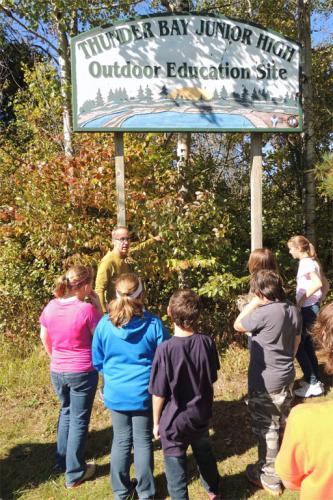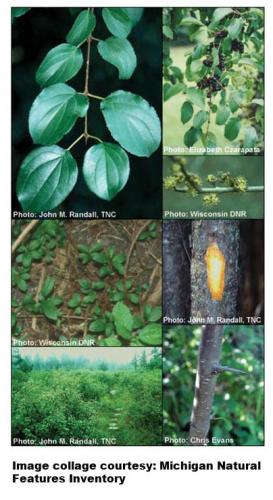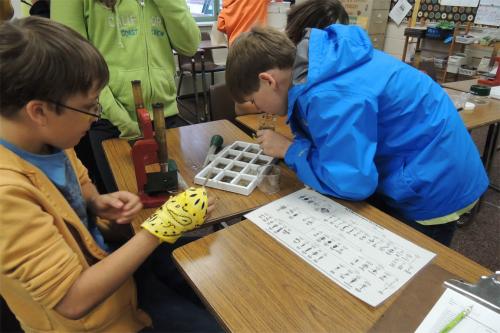Alpena youth combat invasive species to recover and enhance Bagley Creek
Collaborating with conservation partners, Alpena students research water quality, remove invasive species, and seek to restore stream bank habitats of Bagley Creek and beyond.
What is an invasive species? Why are they of concern? How can we be involved, locally, in addressing this issue? These are some of the environmental stewardship questions being researched by sixth grade students at Thunder Bay Jr. High (Alpena Public Schools) as they work with conservation partners in the wetland habitats of Bagley Creek. These students, led by teachers Tim Pollard and Cassy Suszek, are becoming intimately invested in this local conservation issue in their own b ackyard - literally. Bagley Creek - a small tributary of Thunder Bay River Watershed - runs directly through their school’s outdoor education site.
ackyard - literally. Bagley Creek - a small tributary of Thunder Bay River Watershed - runs directly through their school’s outdoor education site.
In the second year of their project, students are learning about invasive species and the environmental, social, and economic challenges they pose for our Great Lakes communities. In northeast Michigan, invasions have resulted in major disruptions to the Lake Huron food web and fishery and have also been identified as a threat to biodiversity. Moving upriver and inland of Lake Huron, students are learning about common and glossy buckthorn, an invasive plant that has been choking out their local Bagley Creek. This shrub crowds out all other plant life making wetlands impassable. Conservation groups, such as Huron Pines, recognize buckthorn as a priority problem in wetlands across Northeast Michigan. Yet, the Michigan Natural Features Inventory offers management strategies as an opportunity to control invasive plants such as buckthorn.
Getting their hands dirty, students are digging into a habitat restoration project aimed at solving this problem. In April 2012, more than 200 students assisted in removing invasive buckthorn from a one-quarter mile stretch of the creek. Returning this past October, nearly 300 students in this year’s classes worked with partners to cut buckthorn out of yet another one-quarter mile stretch of shoreline. The stump s were later treated with herbicide and the branches chipped to mulch trails within the nature area. The annual effort has now become “Buckthorn Day” for all sixth graders, and teachers plan to continue this effort hoping to recover their school’s natural area and creating awareness of the issue among their community. Through the management partnership, the school’s outdoor education site can serve as a community model by demonstrating best practices for landowners who also have invasive plants present.
s were later treated with herbicide and the branches chipped to mulch trails within the nature area. The annual effort has now become “Buckthorn Day” for all sixth graders, and teachers plan to continue this effort hoping to recover their school’s natural area and creating awareness of the issue among their community. Through the management partnership, the school’s outdoor education site can serve as a community model by demonstrating best practices for landowners who also have invasive plants present.
The school’s nature area trails offer access to the creek at ideal locations. Students are able to study the problem of invasive spread and sedimentation impacting the creek as they explore possible solutions. Students have spent several days in their nature area exploring, mapping, and learning about plants and animals, and habitats and ecosystems found within the natural area. Students gain an invaluable hands-on learning experience exploring environmental science topics such as watersheds and ecosystems, plant-biology, biodiversity and invasive species - not to mention learning, first-hand, how people interact as part of these ecosystems.
These students are surrounded by partners invested in their project in collaborating with the Northeast Michigan Great Lakes Stewardship Initiative. The U.S. Fish and Wildlife Service, Huron Pines along with AmeriCorps, DPI Foresters and A Step Above Tree Service all participated in either education or assistance removing, buckthorn from the banks of Bagley Creek. Michigan State University Extension and the Michigan Sea Grant, Thunder Bay National Marine Sanctuary and the NOAA B-WET programs have supported students’ investigations of water quality. The hope is that students can document water quality changes resulting from their habitat improvement efforts. These community partners, among others, have provided valuable expertise for the success of the Bagley Creek restoration project. In trade, they are gaining enthusiastic student partners in advancing their collective interests toward promoting healthy water environments and addressing the issue of invasive species.
With a holistic approach to place-based education projects like this, students learn much more than how to study water quality or remove invasive plants. They learn about the value of contributing to their community through stewardship of local natural resources. The project does not finish with buckthorn remov
For more information about the Northeast Michigan Great Lakes Stewardship Initiative and place-based education programming partnerships with Alpena Public Schools, visit the NE MI GLSI website and Alpena Public Schools’ Bagley Creek project page.



 Print
Print Email
Email




